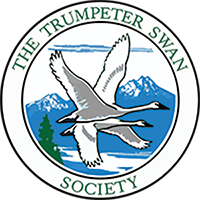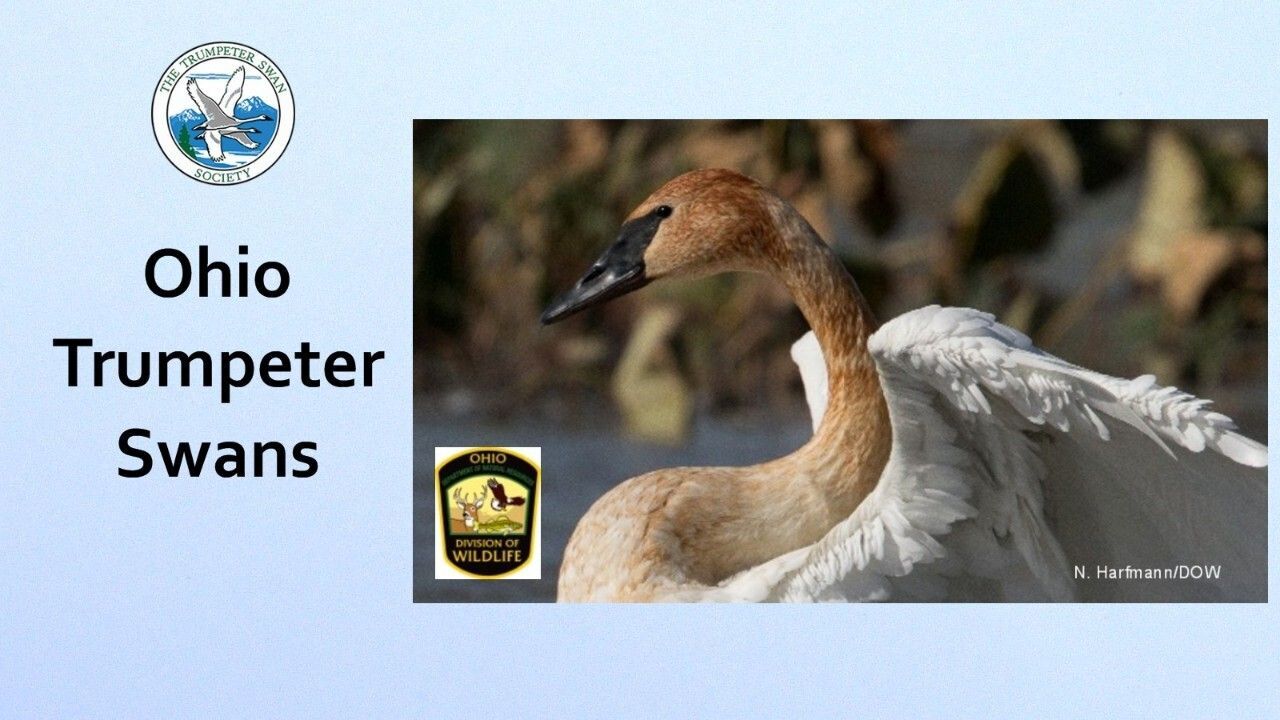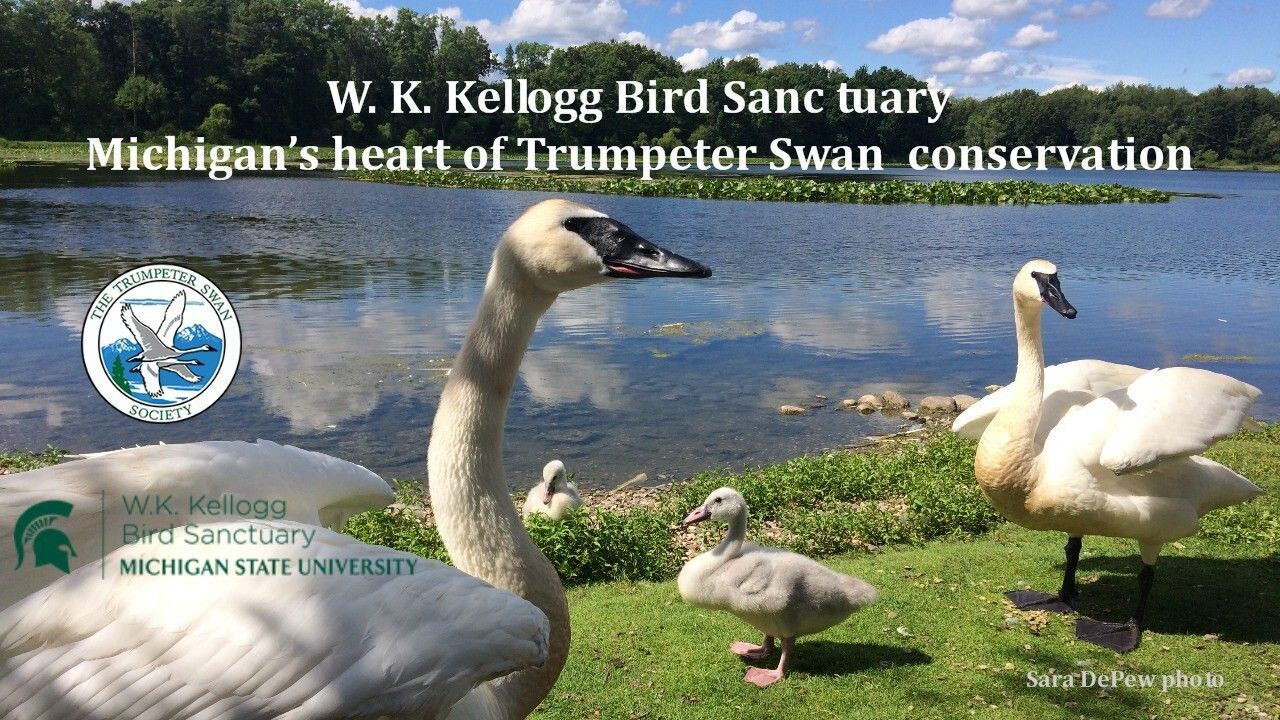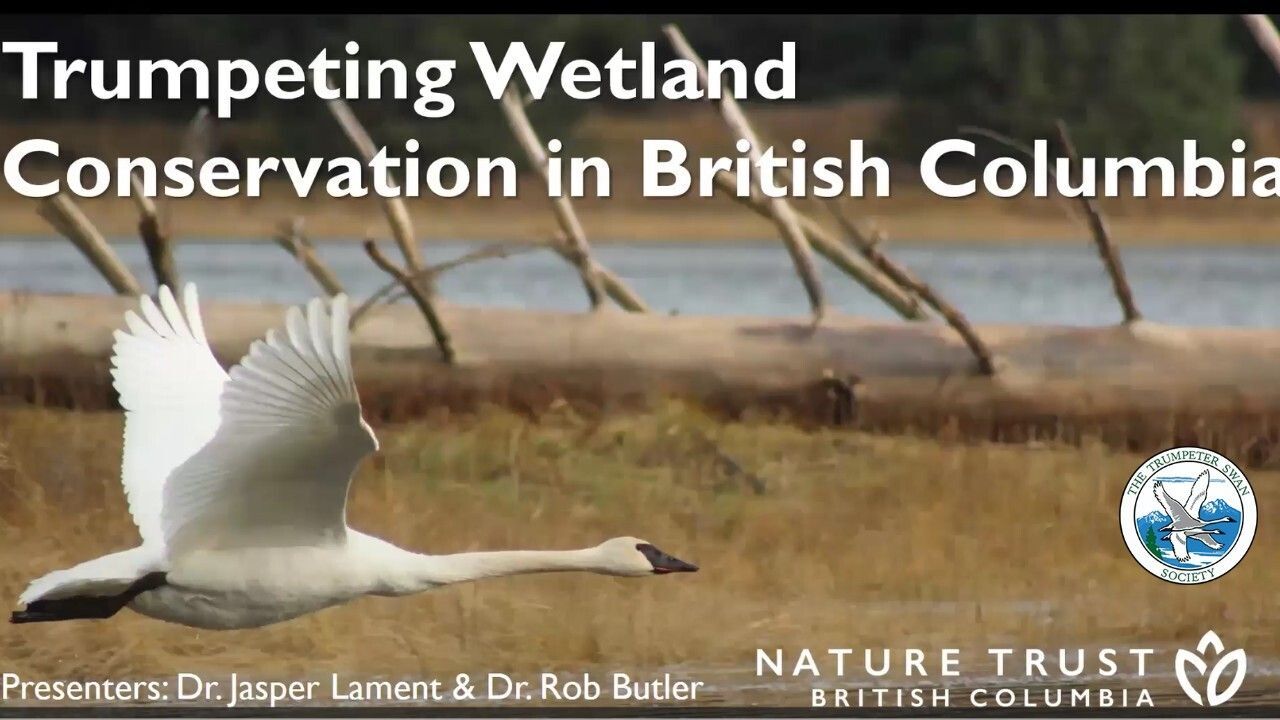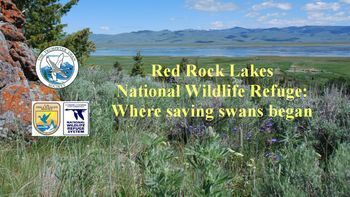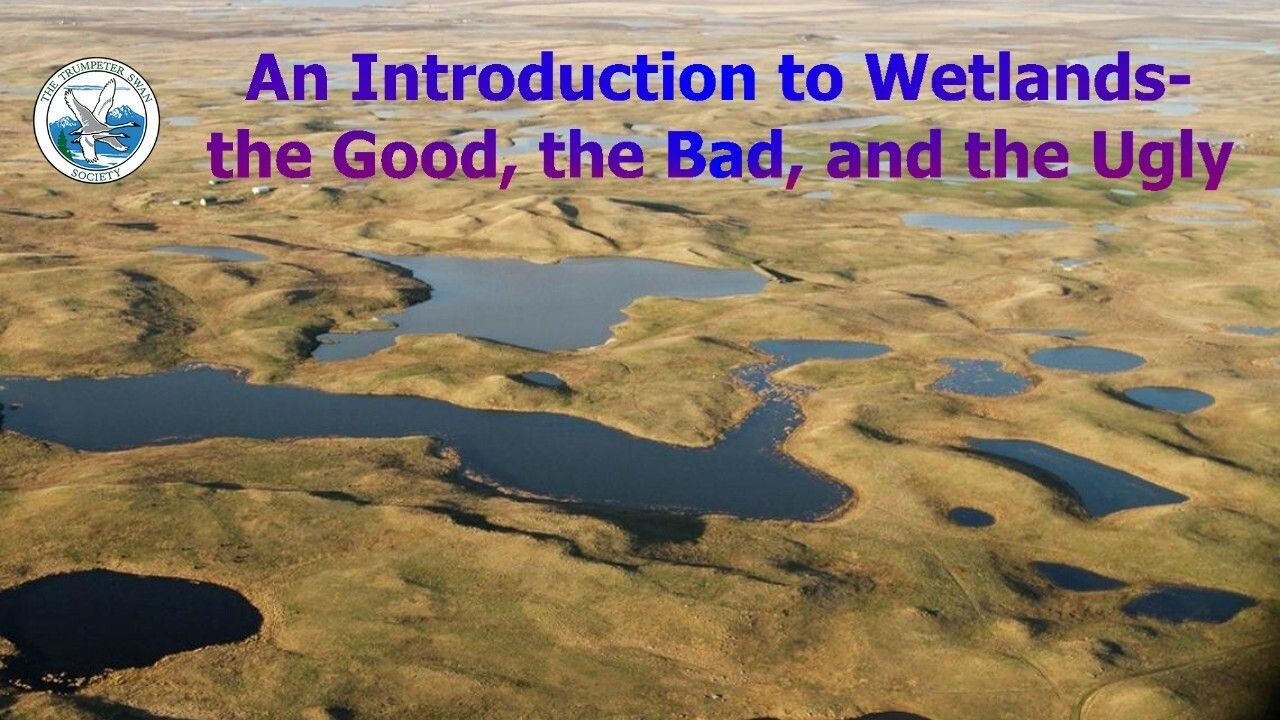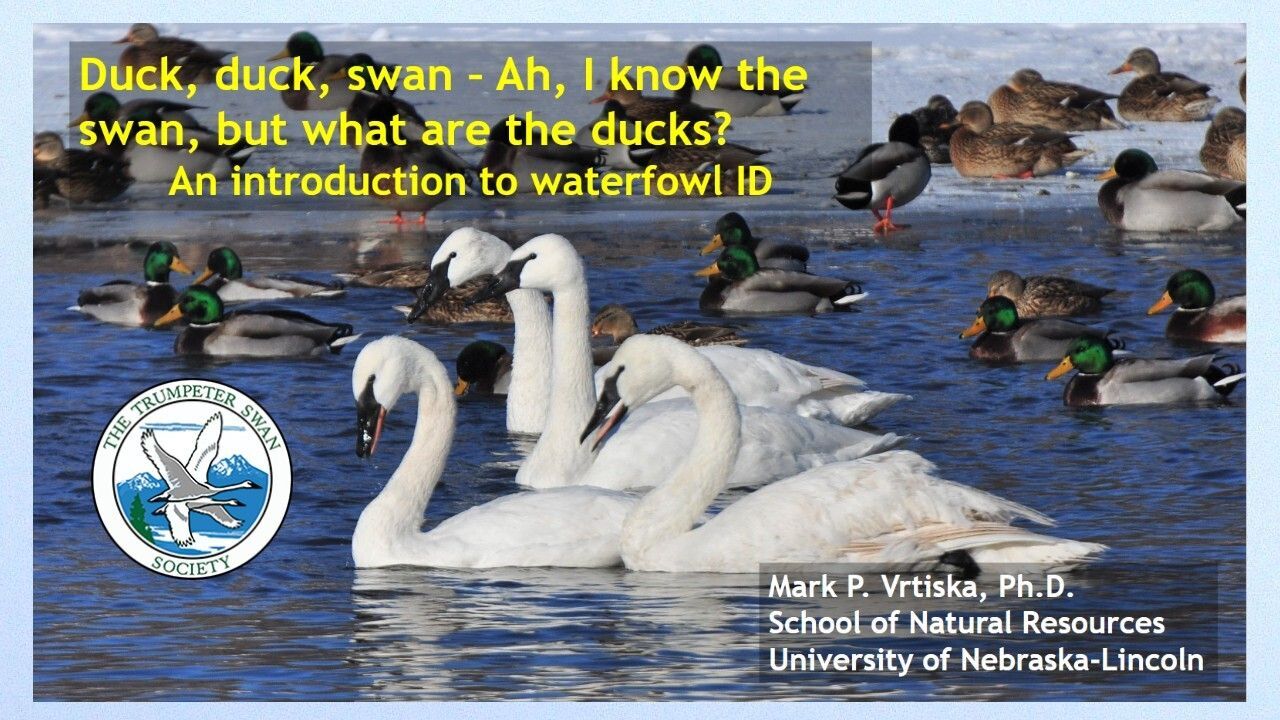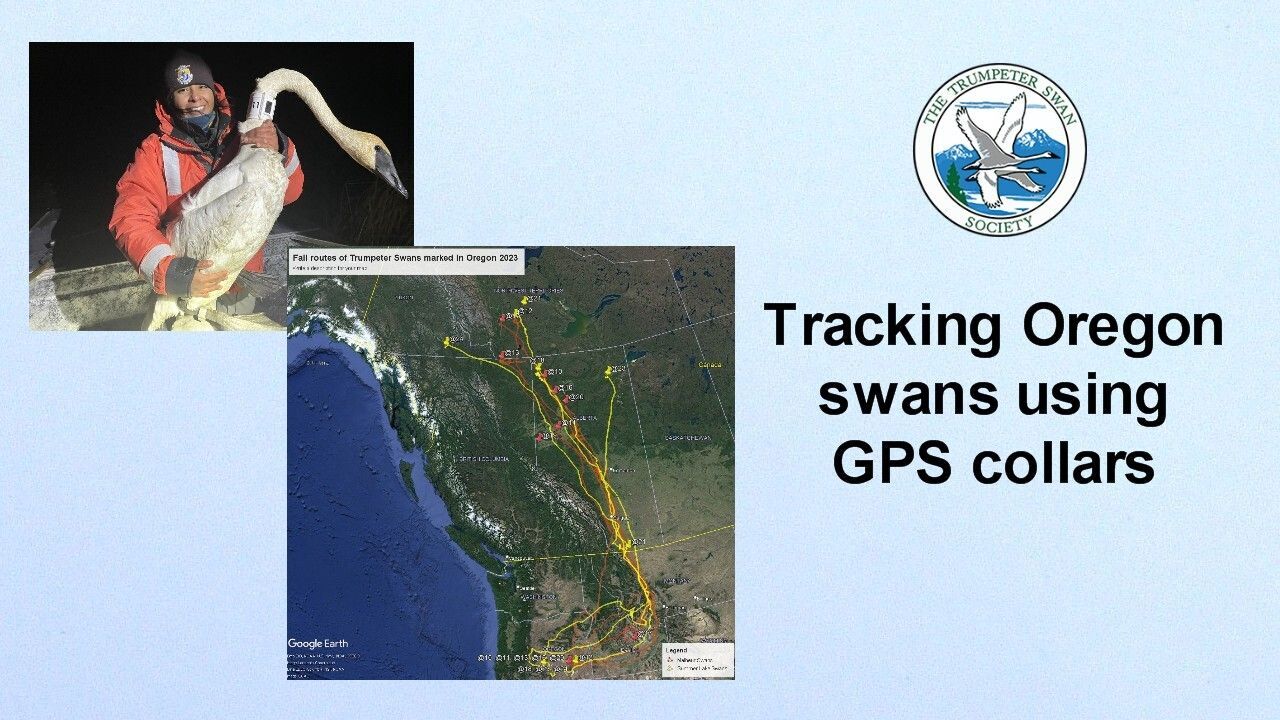Photograph by Margaret Smith
2025 TTSS News Archive
News Highlights from 2025
BRITISH COLUMBIA: "Trumpeter swans are back on the Kootenay River, settling in for their winter stay. They come through the region every year, but it never gets old seeing them glide along the quiet stretches of water, especially when the light is soft and the valley is still."
Read more...
Ohio restored trumpeter swans to the state between 1996-2003.
In this webinar you will discover the process required by a state for trumpeter swan restoration, including the role of the Flyway approval.
You’ll learn how the state’s historic wetland loss and growth of the non-native mute swan population influenced management actions as Ohio worked to ensure the best wetland habitat for trumpeter swans.
You’ll also explore the fascinating movements of Ohio trumpeter swans with GPS/GSM collars that were part of the larger Midwest trumpeter swan movement research.
Presenter: Laura Kearns, PhD., Ohio Division of Wildlife
Dec. 9, 2025
"The presentation was very informative, Interested in the history and the collaborations with many different organizations, zoos and individuals. Good maps and graphs. Congratulations on restoration!
WISCONSIN: "Along the shore of Madison’s Lake Monona, a quiet, wintry scene is interrupted by a cacophony of honks, hoots and coos.
It’s migration season, and thousands of tundra and trumpeter swans — along with waterfowl of all kinds — have descended upon the city’s lakes as part of their trip south." Read more...
UTAH: "The first of tens of thousands of swans making their annual fall visit are showing up at the Bear River Migratory Bird Refuge.
“Want to see flocks of swans? Now is the time!” the refuge announced online. “Swan migration is in full swing here in Utah, and the refuge is one of the best places to watch and listen to these incredible birds.
“Right now, you can often spot large groups resting and feeding in open water and flooded fields especially during the early morning and evening hours.” Read more...
Shared through Facebook, this sunset sighting of trumpeter swans flying had a big reaction.
The North American Waterfowl Management Plan (NAWMP) celebrates 40 years of conservation progress in 2026.
Some of the lessons from NAWMP are clear and simple. NAWMP was built on voluntary partnerships, people working together from Canada to Mexico to achieve big things while no one was truly "in charge".
Migratory birds with their flyway connections have natural powers to bring people together in a common cause. Partners need to care about outcomes, not credit. Integrity and trust are crucial, as is evaluating programs and adapting to biological and social change.
In this webinar, you’ll learn the inspiring story of people, partnerships, and action for continental conservation that continues today! And you’ll discover your place in this ongoing conservation success story.
Presenter:
Mike Anderson, PhD., has been involved with the Plan since its inception
November 20, 2025
"It was an awesome presentation…I learned a lot about the 40 years of conservation efforts..and was especially interested in the many partnerships that enabled this to happen!"
Did you ever wonder what swans are doing, and why? Now you can find out!
Watch short and engaging videos of swan behaviors. Explore swan behaviors during the year- from building a nest, to caring for cygnets, feeding, preening, mating and more!
Discover the beauty and fun moments of swan behavior.
Learn how to recognize and prevent some swan health and safety issues.
By the end of the webinar you’ll know how to anticipate displays, flight take-offs, and the iconic heart shapes for your personal photos and videos!
Welcome to the wonderful world of swan behavior!
Swan Expert presenters: Dr. Gary Ivey, Carrol Henderson
October 30, 2025
“The short videos of their behavior were wonderful, and their interpretation by the two experts was especially helpful. Great job!”
WASHINGTON: "ecovery has been the work of conservation organizations, tribes, and county officials, all of whom have supported action and programs that support the natural diversity of this region.
With the fall of each year, the Salish Sea region is witness to the arrival of the great migrations of waterfowl, shorebirds and raptors that move through this region or remain through the winter.
One wintering species in particular, the trumpeter swan, is a stark and glowing presence when feeding as a flock or family group on the dark bottom lands or flying overhead in formation. Reaching weights of about 30 pounds and aloft on wings that may span over eight or more feet, they are hard to miss..."
The W.K. Kellogg Bird Sanctuary played a crucial role in the successful reintroduction of the Trumpeter Swan in the state of Michigan. The effort was led by the late Joe Johnson, Manager. Discover the fascinating story of almost 100 years of waterfowl conservation, research, and education at this special nature center. The Sanctuary is a must-visit destination. Although active management of Trumpeter Swans is no longer necessary in Michigan, you’ll learn about the current population and the factors impacting them today. You’ll also explore the travels of thirteen Michigan swans that were part of the Midwest GPS tracking study.
Presenter: Lisa Duke, Sanctuary Grounds Manager
NEBRASKA: TTSS Board member, Dr. Mark Vrtiska, was awarded Early Career Award with a lifetime experience in waterfowl. "Mark Vrtiska's win of the 2025 Early Career Faculty Award in the School of Natural Resources may be one for the record books...He had worked at the Nebraska Game and Parks Commission the prior 21 years, Ducks Unlimited for three years before that and various waterfowl jobs throughout college and the year between his undergraduate studies at Nebraska and graduate studies at Eastern Kentucky University and Mississippi State University...The director of the School of Natural Resources said Vrtiska's work with students and stakeholders has especially made him deserve the Early Career Faculty Award." Read more...
WASHINGTON: A family of trumpeter swans makes an appearance at Turnbull National Wildlife Refuge in this photo by Cindy Miller.
British Columbia played a critical role in the survival and recovery of trumpeter swans. The province is the winter home of thousands of migrating trumpeter (and tundra) swans from Alaska and Yukon. British Columbia has both winter and summer nesting swan habitats- such as coastal estuaries, river valleys, and farmlands. However, these important habitats are often located on private lands.
In this webinar you’ll discover how the Nature Trust of BC and its partners purchased, protected, restored, and managed thousands of acres of key swan habitats since 1971. Success stories are shared, along with the stories of some of the special properties used by swans. The webinar showcases the beauty of these protected properties! You’ll learn about opportunities for both American and Canadian swan enthusiasts to accelerate conservation of even more swan habitat in BC.
Presenters:
Dr. Jasper Lament, CEO, The Nature Trust of British Columbia
Dr. Robert Butler, former Board Member, The Nature Trust of British Columbia
This webinar is an educational program of The Trumpeter Swan Society
NEBRASKA: Trumpeter swans are creatures of habit(at).
Good read by our own Trumpeter Swan Society Board member Mark Vrtiska on trumpeter swans in the Nebraska Sandhills.
Key points from his Nebraskaland Magazine article:
▪️Site loyalty: 38 GPS-tagged swans showed 80% return to the same nesting wetland and just over 70% to familiar wintering areas.
▪️Quality matters: Their preferred spots are clear, plant-rich waters—good indicators of overall wetland health.
▪️Why it matters: As Mark writes, “Swans are the big, white ‘canaries’ of high-quality wetlands, lakes, creeks and rivers.” Their status reflects how well we’re caring for these places—and, by extension, our own environment.
Discover the pivotal role this wild and beautiful refuge played in saving trumpeter swans.
The remote Centennial Valley is on the north side of the Continental Divide, in Southwest Montana. It is a vast, high elevation, nearly intact, landscape of forest, sagebrush steppe, wet meadow, and the largest wetland complex in the 20 million-acre Greater Yellowstone Ecosystem.
The Red Rock Lakes NWR was established in the Valley in 1935 by President Franklin Roosevelt to save what was believed to be the nearly extinct trumpeter swan. In addition to helping save the swan, the result has been extraordinary conservation of other iconic wildlife on the brink in the Yellowstone Region.
Presenter: Bill West, Retired Red Rock Lakes National Wildlife Refuge Manager
ALASKA: "FAIRBANKS, Alaska (KTUU) - Migratory birds have returned to Fairbanks for the spring and summer, as Creamer’s Field Migratory Waterfowl Refuge prepares the red carpet for their new arrivals." Read more...
WEBINAR: Wetlands are an important ecosystem that provide habitat for plants and animals, but have multiple benefits to humans as well. In this webinar, you will learn:
• How to know if you’re looking at a wetland
• The different kinds of wetlands you may see or have in your area
• Wetland functions and benefits
• The current status of wetlands (losses, threats and protection)
· And, finally, how you can help.
WISCONSIN: "Almost every spring, swans break their northward migration with a stop in Northeast Wisconsin.
That time of year has arrived, despite the near-freezing temperatures that make spring seem distant. But on Monday, thousands of swans descended into Shiocton, signifying spring may not be far off."
ALASKA: You can watch the Trumpeter Swan Society film, Return of the Trumpeters, at this festival. "Creamer’s Field Migratory Waterfowl Refuge in conjunction with the Alaska Department of Fish & Game celebrates the arrival of spring as migratory species return to Interior Alaska. Late April is an ideal time to view trumpeter swans, Canada geese, white-fronted geese and different duck species.
Activities include guided nature walks, bird watching, wildlife viewing, falconry demonstrations and crafts for kids. You can also visit the Farmhouse Visitor Center in the Creamer family farmhouse, established in the early 1800s, which showcases exhibits on migratory birds and its dairy farm history.
The free event welcomes all ages – just dress appropriately and wear boots!" Click for the festival link
IDAHO: "It is amazing what a few days of warm weather can bring into southeastern Idaho, by softening the snow and exposing grains, rotten potatoes and seed-producing plants left for migrating birds.
Deer Parks Wildlife Management Area west of the Menan Buttes has become a very busy place this past week with hundreds of trumpeter swans, Canada geese, and ducks showing up to feed. In a harvested corn field across from Ririe High School, hundreds of trumpeters and Canadas have also found enough leftover corn to draw them to that field." Read more...
WEBINAR: Other waterfowl can be found with Trumpeter Swans? If you don't know what species they are, this webinar will provide a preliminary guide to identifying the most common duck and goose species you may see, whether you live in the east, midwest or west.
IOWA: "Swans mate for life, and they perform an elaborate courtship dance to cement their bond. They typically breed during the spring or summer, with some species traveling to the Arctic in flocks to do so. They build huge nests at the edge of the water, where a female swan lays between three and eight eggs. Both parents take turns incubating the eggs. When hatched, cygnets stay with their parents for several months before joining a flock." Read More...
MINNESOTA: Watch this interview and see and learn about Minnesota's swan restoration program. Listen to special heartwarming stories of swan love which Carrol Henderson witnessed as he worked as MN DNR's Nongame Wildlife Program director
UTAH: "SALT LAKE CITY — As warmer weather approaches, migrating swans will pass through Utah as they journey north. If you’d like to see them, the Utah Division of Wildlife Resources recommends three prime viewing spots near Great Salt Lake. Salt Creek Waterfowl Management Area, Bear River Migratory Bird Refuge, Farmington Bay Waterfowl Management Area." Read and see more...
MINNESOTA: The Mississippi River near Monticello, the Otter Tail River in Fergus Falls, and the Minnesota River Valley National Wildlife Refuge in the Twin Cities rank among popular viewing areas, but they may be sighted on any generous stretch of open water statewide. Apps such as eBird and iNaturalist track recent swan sightings.
ARKANSAS: When Ozarks at Large’s Jack Travis visited Magness Lake this weekend, he saw plenty of swans, more than a few ring-neck ducks and even a few seagulls paddling about in the water. As he stood among a few other birders, he captured the haunting sound of the winter visitors.
PENNSYLVANIA: A rare and exciting bird visitor has excited residents in Pennsylvania. Read more...
In February 2023, a dozen swans were captured and received GPS collars at Oregon’s Summer Lake Wildlife Area and Malheur National Wildlife Refuge. Biologists wanted to know where these swans spend the summer, their migration routes in spring and fall, and if they raised families.
This webinar highlights how and where the swans were captured and collared. Then we explore some of the results, teaching you how to use GoogleEarth and the GPS data to discover:
• How to see the wetlands where the swans were captured and collared- from a bird’s eye view to a landscape street view.
• How to do simple calculations like a biologist to determine flight speed, temperatures, distances and altitude.
WISCONSIN: “Yesterday we had an unusual request for assistance. Members of the public witnessed a swan that was frozen to the ice on the St. Croix River. The local conservation warden was unavailable, and not wanting citizens to try and perform a rescue themselves, Hudson Fire sent a crew to help out. We were successful in bringing the swan to shore to receive care from citizens. This is not something we would normally do, but risk the vs reward in preventing someone from the public falling through the ice was worth it. Remember, ice is never completely safe, especially in the river where the currents are always moving.”
